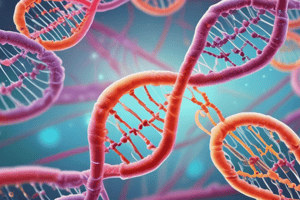Podcast
Questions and Answers
What is the primary reason for condensing DNA molecules into chromosomes during cell division?
What is the primary reason for condensing DNA molecules into chromosomes during cell division?
During DNA replication, what is the role of free nucleotides?
During DNA replication, what is the role of free nucleotides?
What is the significance of the semiconservative model of DNA replication?
What is the significance of the semiconservative model of DNA replication?
In eukaryotic DNA replication, how does replication typically proceed?
In eukaryotic DNA replication, how does replication typically proceed?
Signup and view all the answers
What is the main function of enzymes during DNA replication?
What is the main function of enzymes during DNA replication?
Signup and view all the answers
Why is preventing tangling important during mitosis?
Why is preventing tangling important during mitosis?
Signup and view all the answers
What happens to the parental DNA strands during replication?
What happens to the parental DNA strands during replication?
Signup and view all the answers
Which base pairing is correct in the DNA molecule?
Which base pairing is correct in the DNA molecule?
Signup and view all the answers
What is the primary location of DNA in prokaryotic cells?
What is the primary location of DNA in prokaryotic cells?
Signup and view all the answers
Which statement about eukaryotic chromosomes is correct?
Which statement about eukaryotic chromosomes is correct?
Signup and view all the answers
What is the function of histones in the context of DNA?
What is the function of histones in the context of DNA?
Signup and view all the answers
How does the amount of DNA in eukaryotes compare to prokaryotes?
How does the amount of DNA in eukaryotes compare to prokaryotes?
Signup and view all the answers
During interphase, how is eukaryotic DNA organized?
During interphase, how is eukaryotic DNA organized?
Signup and view all the answers
What happens to the DNA during cell division in eukaryotic cells?
What happens to the DNA during cell division in eukaryotic cells?
Signup and view all the answers
What does the term 'nucleosome' refer to?
What does the term 'nucleosome' refer to?
Signup and view all the answers
Which of the following facts about DNA length in eukaryotic cells is true?
Which of the following facts about DNA length in eukaryotic cells is true?
Signup and view all the answers
Study Notes
DNA Replication
- DNA replication is a process where a cell duplicates its DNA before cell division.
- Replication ensures each resulting cell has a complete set of DNA.
DNA and Chromosomes
- Most prokaryotes have a single DNA molecule in their cytoplasm. This DNA contains nearly all the cell's genetic information.
- Many eukaryotes have 1000 times more DNA than prokaryotes.
- Eukaryotic DNA is located in the cell nucleus inside chromosomes during division. Chromosomes are loose as chromatin during interphase.
- The number of chromosomes varies between species.
- Eukaryotic chromosomes contain DNA and protein, tightly packed to form chromatin.
- Chromatin is DNA tightly coiled around proteins called histones.
- DNA and histone molecules form nucleosomes.
- The DNA of 46 chromosomes in a human cell, laid end-to-end, would be over 2 meters long but coils up to fit into a nucleus only 5µm in size.
- Tight condensation of DNA into chromosomes is important for preventing tangling and making separation and division more efficient during mitosis.
DNA Replication Process
- In eukaryotes, DNA replication occurs at hundreds of places (origins of replication).
- Replication proceeds in both directions.
- DNA replication follows a semi-conservative model.
- The two DNA strands separate.
- Each strand acts as a template for assembly of a complementary strand from free nucleotides.
- Each newly replicated DNA (daughter) molecule consists of one original (parental) strand and one new strand.
- DNA replication is carried out by enzymes that “unzip” the DNA molecule. Hydrogen bonds between base pairs are broken, and the two strands unwind.
- The main enzyme involved in DNA replication is DNA polymerase.
- DNA polymerase joins individual nucleotides to produce a DNA molecule.
- DNA polymerase also "proofreads" each new strand to prevent mistakes.
Quote about Paths Without Obstacles
- “If you find a path with no obstacles, it probably doesn't lead anywhere”.
Studying That Suits You
Use AI to generate personalized quizzes and flashcards to suit your learning preferences.
Related Documents
Description
Test your knowledge on the processes of DNA replication and the structure of chromosomes. This quiz covers essential concepts such as the differences between prokaryotic and eukaryotic DNA, chromatin structure, and the importance of DNA condensation in cell division.




